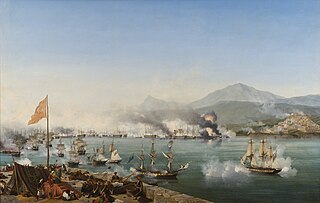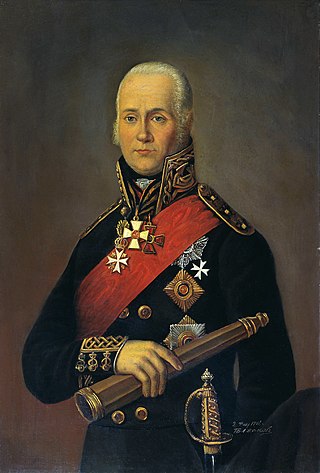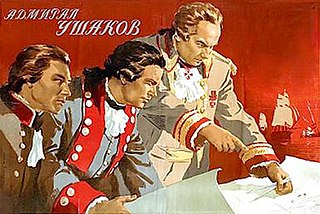
Kerch, also known as Keriç or Kerich, is a city of regional significance on the Kerch Peninsula in the east of Crimea. Kerch has a population of about 147,033 .

The Battle of Navarino was a naval battle fought on 20 October 1827, during the Greek War of Independence (1821–29), in Navarino Bay, on the west coast of the Peloponnese peninsula, in the Ionian Sea. Allied forces from Britain, France, and Russia decisively defeated Ottoman and Egyptian forces which were trying to suppress the Greeks, thereby making Greek independence much more likely. An Ottoman armada which, in addition to Imperial warships, included squadrons from the eyalets of Egypt and Tunis, was destroyed by an Allied force of British, French and Russian warships. It was the last major naval battle in history to be fought entirely with sailing ships, although most ships fought at anchor. The Allies' victory was achieved through superior firepower and gunnery.

The Battle of Sinop, or the Battle of Sinope, was a naval battle that took place on 30 November 1853 between Imperial Russia and the Ottoman Empire, during the opening phase of the Crimean War (1853–1856). It took place at Sinop, a sea port on the southern shore of the Black Sea. A Russian squadron attacked and decisively defeated an Ottoman squadron anchored in Sinop's harbor. The Russian force consisted of six ships of the line, two frigates and three armed steamers, led by Admiral Pavel Nakhimov; the Ottoman defenders were seven frigates, three corvettes and two armed steamers, commanded by Vice Admiral Osman Pasha.

The naval Battle of Cheshme took place on 5–7 July 1770 during the Russo-Turkish War (1768–1774) near and in Çeşme Bay, in the area between the western tip of Anatolia and the island of Chios, which was the site of a number of past naval battles between the Ottoman Empire and the Republic of Venice. It was a part of the Orlov Revolt of 1770, a precursor to the later Greek War of Independence (1821–1829), and the first of a number of disastrous fleet battles for the Ottomans against Russia. Today it is commemorated as a Day of Military Honour in Russia.

The Battle of Cape Kaliakra was the last naval battle of the Russo-Turkish War (1787–1792). It took place on 11 August 1791 off the coast of Cape Kaliakra, Bulgaria, in the Black Sea. Neither side lost a ship, but the Ottomans retreated to Istanbul afterward.

The Battle of Tendra was a naval action fought on 8 and 9 September 1790 in the Black Sea as part of the Russo-Turkish War (1787–1792). It ended in a decisive victory for Ushakov's Russians over the Ottomans.

The naval Battle of Fidonisi took place on 14 July 1788 (NS) between the fleets of the Russian Empire under Marko Voinovich's lead and the Ottoman Empire under Cezayirli Hasan Pasha during the Russo-Turkish War (1787–1792) in the area of Snake Island, which in Greek was called Fidonisi (Φιδονήσι). It was a Russian victory.

Fyodor Fyodorovich Ushakov was a Russian naval commander and admiral. He won every engagement he participated in as the admiral of the Russian fleet, and is regarded as one of the greatest naval commanders in history, and one of the most capable naval commanders of Russia of all time.
These battles took place during the Russo-Turkish War, 1768-1774, on 20 June and 9 July 1774 south of Kerch, Russian Empire.

The naval Battle of the Dardanelles took place on 22 May 1807 as a part of the Napoleonic Wars during the Russo-Turkish War of 1806–1812. It was fought between the Russian and Ottoman navies near the Dardanelles Strait.

Vice Admiral Vladimir Alexeyevich Kornilov was a Russian naval officer who took part in the Crimean War and is known for his battle against the Pervaz-ı Bahrî in what is considered the first battle between steam ships.

The territory of Crimea, previously controlled by the Crimean Khanate, was annexed by the Russian Empire on 19 April [O.S. 8 April] 1783. The period before the annexation was marked by Russian interference in Crimean affairs, a series of revolts by Crimean Tatars, and Ottoman ambivalence. The annexation began 134 years of rule by the Russian Empire, which was ended by the revolution of 1917. The annexation resulted in the end of the Crimean slave trade, which had been one of the major slave trades from Europe for centuries.

Admiral Ushakov is a 1953 Soviet historical war film directed by Mikhail Romm and starring Ivan Pereverzev, Boris Livanov and Sergei Bondarchuk.

Feyzâ-i Bahrî was one of four wooden-hulled Mecidiye-class paddle frigates built for the Ottoman Navy in the 1840s; they were the first Ottoman-built warships powered by steam. She served with the fleet until 1867, including during the Crimean War, where she saw a minor battle with a Russian frigate in the Black Sea. Feyzâ-i Bahrî ferried soldiers to Crete during the Cretan Revolt in 1866 and was converted into a dedicated transport vessel the following year. She served in that capacity until 1878 when she was decommissioned, being broken up in 1880.
The Egypt Eyalet began a military intervention in Crimea at the request of the Ottoman Sultan Abdulmejid I after the Russian armies crossed the Prut River in 1853, they occupied the states of Wallachia and Moldavia, and peaceful efforts failed to resolve the deteriorating situation.














